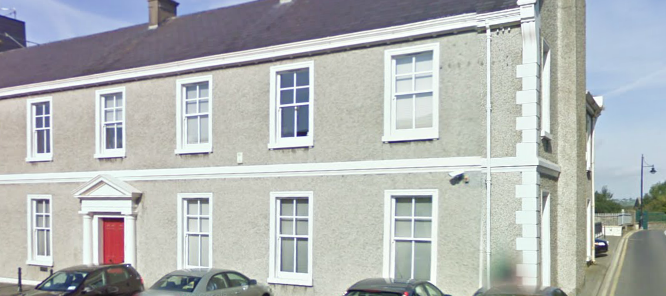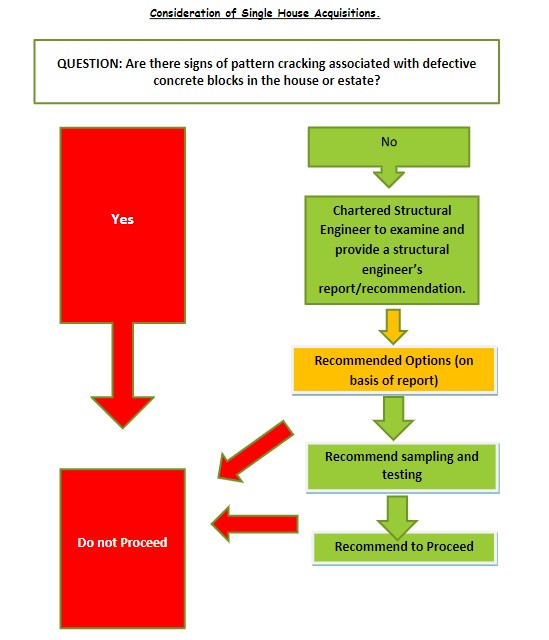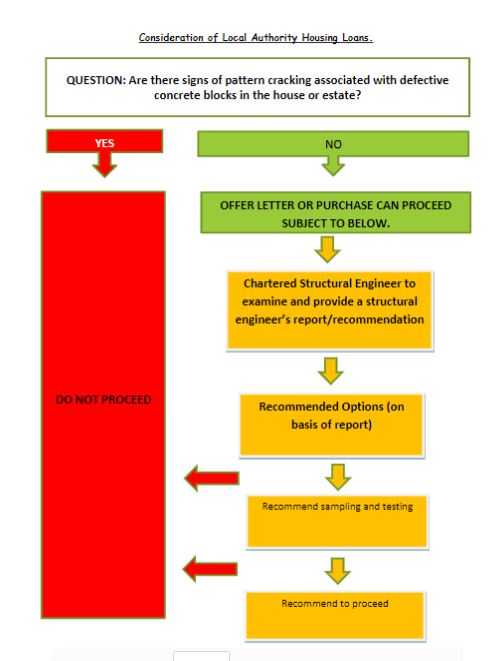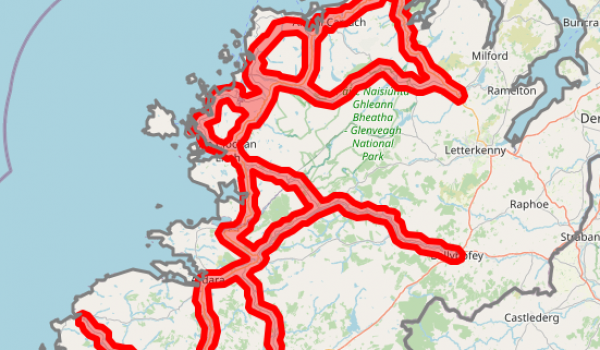
Donegal County Council has adopted a set of new policies to allow tenant purchases and local authority loans to proceed in the county.
A policy has also been adopted which governs single house acquisitions by the council.
All three had been temporarily suspended as a result of the defective blocks crisis.
Last evening after some discussion, members of Donegal County Council adopted the new polices.

In each case, if there is any sign of cracking in the blocks, the sale, purchase or loan will not be proceeded with.
If there is no indication of structural damage, then independent structural analysis of the house will be undertaken, and if that is clear, the deal can be proceeded with.
However, in the case of tenant purchases, if the house was constructed in the 1980s or earlier, then the deal can go ahead without testing, once there is are no structural issues.
The provisions will be reviewed in a year.

Scenario 1: Where there are signs of pattern cracking associated with
defective blocks in the house or in the estate where the house is located.
• In such circumstances, the Council will not proceed with offering or
completing a sale of a house under the TP Scheme at this time
(irrespective of the year of construction).
Scenario 2: Where there are no signs of pattern cracking associated with
defective blocks in the house or in the area or estate where the house is
located.
a) Houses built in 1980s or earlier.
• The Council will proceed with the application as normal, in line with the
normal process. No testing of blocks to be carried out.
3 | P a g e
b) Houses built in the 1990s or later, (i.e. identified as a higher risk
period).
• The Council will arrange for testing of blocks until further notice.
• Once the tests results are received, the Council will share the results
with the tenant, and advise the tenant to seek structural engineering
and legal advice.
• A decision will be taken on a case-by-case basis, once the results have
been considered.
• The matter will be reviewed over time as further knowledge and
expertise is made available resulting from ongoing research as
commissioned by the Department of Housing, Local Government and
Heritage.

Scenario 1: Where there are signs of pattern cracking associated with defective
blocks in the house, or in the estate where the house is located.
• In such circumstances, the Council will generally not proceed with the acquisition,
except in exceptional circumstances.
Scenario 2: Where there are no signs of pattern cracking associated with defective
blocks in the house, or in the estate where the house is located, and irrespective of
year of construction:
• The Council will procure and engage an independent Chartered Structural Engineer
(with appropriate Professional Indemnity Insurance),
o to inspect and produce a report on the condition of the property,
o with the prior consent from the property owner/vendor.
• Once the Chartered Structural Engineer’s report is available the Council will consider
the following options:
(a) Do not to proceed with the acquisition.
• The Council will withdraw any interest in acquiring the property.
(b) Request that sampling and testing of the blockwork is carried out.
• The owner/vendor to confirm that they are willing to undertake and cover the
cost of the sampling and testing.
• The Chartered Structural Engineer will determine the location and number of
samples to be taken and advise the owner/vendor accordingly.
• The owner/vendor will arrange for a competent contractor to take the
required samples from the locations identified in accordance with I.S. 465 (as
amended). The Chartered Structural Engineer shall be in attendance.
• The Council will bear no responsibility whatsoever for the taking of the
samples or reinstatement works to the property.
• The owner/vendor will send the core samples to an accredited laboratory for
testing and analysis in accordance with I.S. 465 (as amended) and submit a
Professional Geologist/Laboratory Report to the Council.
• The Chartered Structural Engineer will review the Geologist/Laboratory
Report and provide advice to the Council so that they can either proceed or
not proceed with the acquisition.
(c) Proceed without sampling and testing of the blockwork.
• This may arise in older properties where no major concerns are raised by the
Chartered Structural Engineer in their Independent Structural Engineer’s
Report.
• In such cases, the Council will proceed to acquire the property through the
normal conveyance process.

Scenario 1: Where there are signs of pattern cracking associated with defective
blocks in the house, or in the estate where the house is located.
In such circumstances, the Council will not proceed with offering loan finance at this time
(irrespective of the year of construction).
Scenario 2: Where there are no signs of pattern cracking associated with defective
blocks in the house, or in the estate where the house is located, irrespective of year
of construction.
Procedure
a) The Purchaser must engage an independent Chartered Structural Engineer (with
appropriate Professional Indemnity Insurance), to inspect the property and prepare
a report and recommendation.
b) The report should contain a clear indication that they are satisfied in relation to the
structural condition of the property, with an unequivocal recommendation to the
prospective purchaser that they can proceed to acquire the property, or
c) The report should contain a clear opinion on whether further assessment and/or
testing is required with specific reference to defective blocks. Where the
Chartered Structural Engineer recommends further assessment and testing, the
procedures at Scenario 3 (below) must be followed.
d) The prospective purchaser will submit the report and recommendation to the
Council.
e) The Council will examine the report to determine whether or not to provide loan
funding in respect of the subject property.
3
Scenario 3:
A. Where there are no signs of pattern cracking associated with defective
concrete blocks in the house, or in the estate where the house is located, and
further assessment/testing has been recommended by the structural engineer.
Procedure
a) The owner/vendor to confirm that they are willing to undertake and cover the cost
of the sampling and testing.
b) The Chartered Structural Engineer (engaged by the Purchaser) will determine the
location and number of samples to be taken and advise the owner/vendor
accordingly.
c) The owner/vendor will arrange for a competent contractor to take the required
samples from the locations identified in accordance with I.S. 465 (as amended). The
Chartered Structural Engineer shall be in attendance.
d) The Council will bear no responsibility whatsoever for the taking of the samples or
reinstatement works to the property.
e) The owner/vendor will send the core samples to an accredited laboratory for testing
and analysis in accordance with I.S. 465 (as amended) and submit a Professional
Geologist/Laboratory Report to the Purchaser.
f) The Chartered Structural Engineer will review the Geologist/Laboratory Report and
provide clear advice and recommendation to the Purchaser so that they can either
proceed or not proceed with the acquisition.
g) The Purchaser will submit the Structural Engineer’s Report, test results and
Geologist/Laboratory Report to the Council for consideration.
h) The Council will examine the report and determine whether loan funding should be
provided in respect of the subject property.
4
Scenario 4 – For Self-Build Properties under a fixed price contract
Procedure
a) The applicant shall engage a Professional Architect and Chartered Structural
Engineer (with appropriate professional indemnity insurance) to oversee and
certify that the construction is in compliance with current Building Regulations,
BCAR Process (including Assigned Certifier, Design Certifier and Ancillary
Certifiers) and Planning Permission.
b) The applicant shall appoint a competent Builder to construct the project in
accordance with the plans, specifications and Building Regulations and to sign the
Certificate of Compliance on completion.
c) Prior to commencement of the project, an assessment and consideration of test
results, professional geologist’s report, and Structural Engineers Report
regarding concrete blocks (i.e. presence or not of minerals, sulphides, deleterious
materials, cement content, compressive strength and so forth) must be submitted
to the Council. Some additional testing shall be undertaken on site during
construction.
d) Interim payments during construction will be considered with the appropriate
certification from the Professional Architect, Assigned Certifier and Building
Contractor.
e) Upon completion of the project, the applicant must arrange for certification to be
submitted to the Council by the Professional Architect and Assigned Certifier
confirming that the project has been constructed fully in compliance with the
current Building Regulations, BCAR Process and Planning Permission.
f) Upon completion of the project, the applicant shall submit confirmation from the
competent Builder that the project has been constructed in accordance with the
plans, specifications and Building Regulations, including a Certificate of
Compliance on completion by the competent builder.





